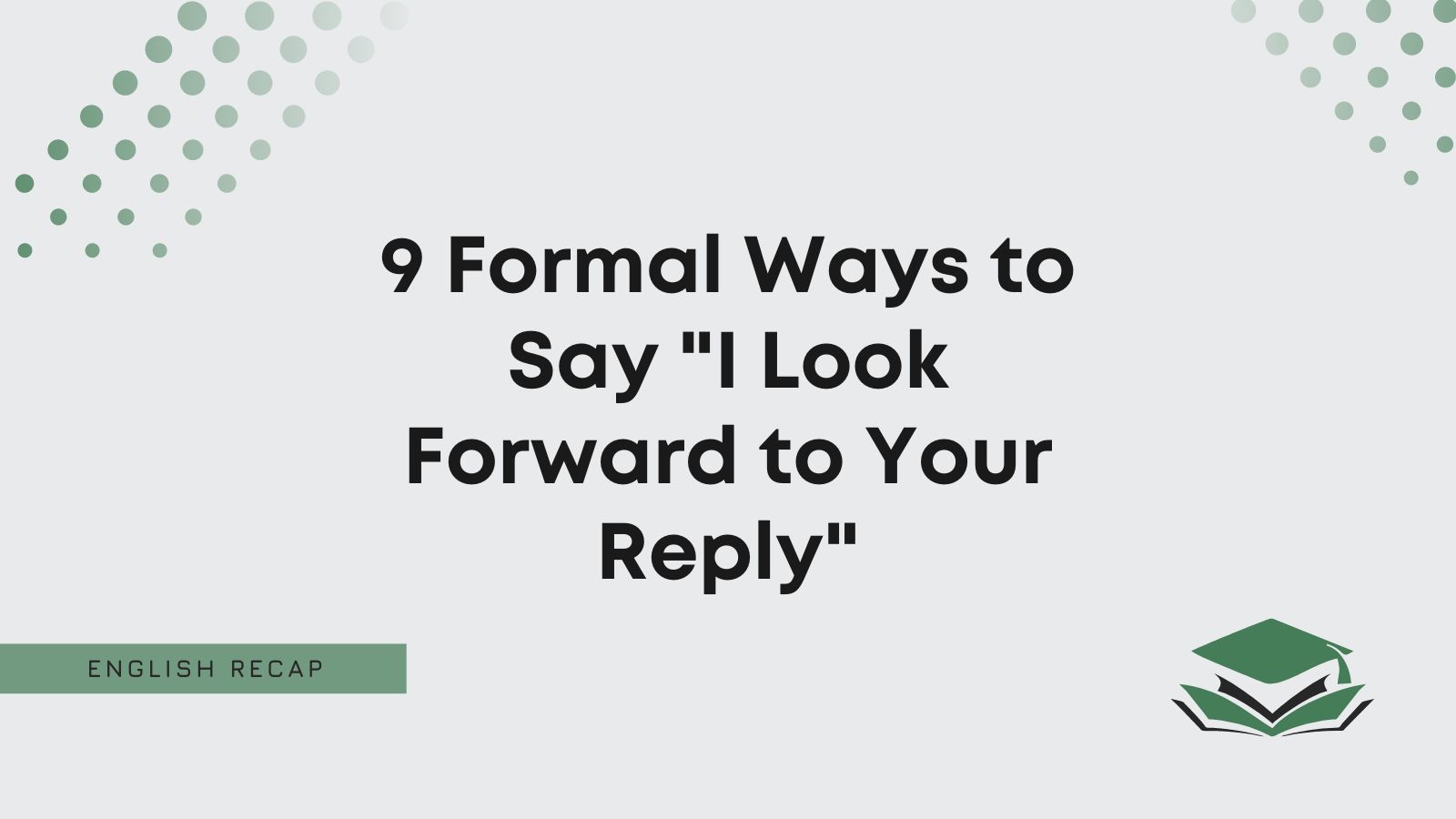So, you’d like someone to reply to you, but you don’t want to sound too pushy.
Perhaps you’re wondering if “I look forward to your reply” is the best way to do this. Or is it a bit too demanding?
Well, you’re in luck!
This article has gathered some synonyms showing you how to say “I look forward to your reply” in an email.
Is It Rude to Say “I Look Forward to Your Reply”?
It is not rude to say “I look forward to your reply.” In fact, it’s a formal way to encourage a reply from the recipient.
So, you’ll often find the phrase in important emails. Basically, anytime you or the sender expects a reply, you can expect to read “I look forward to your reply.”
It’s a polite email closer. And here is an example showing you how to use it:
Dear Matt,
Thanks for the update. I’m sure there are still some things we can fix. Do you have ideas?
I look forward to your reply,
Bethany Dyer
Pros
- It’s formal and appropriate in emails.
- It’s a great closer that encourages someone to reply to you in important situations.
Cons
- It’s a bit bland.
- It’s impersonal and doesn’t always seem friendly.
Keep reading to learn another way to say “I look forward to your reply.” We’ve also provided examples under each alternative to show you how they look in a business email.
What to Say Instead of “I Look Forward to Your Reply”
- I eagerly await your response
- Your timely reply is greatly appreciated
- I look forward to receiving your response
- Please respond as soon as possible
- I’d very much like to hear back from you
- Let me know what you think
- I anticipate your reply in due course
- I would be grateful for your timely response
- Your prompt reply would be most welcome
1. I Eagerly Await Your Response
To make your business email more interesting, try “I eagerly await your response.” It’s a great way to help you mix things up while still sounding formal and polite.
We recommend using it because it’s a direct and effective switch to the original phrase.
For instance, you can replace “look forward to” with “eagerly await.” These are synonymous, and they show you are genuinely looking forward to something.
You can also replace “reply” with “response” to mix things up further. It’s not much of a change, but it’s enough to keep things engaging for readers.
Here’s a great email example to show you how to use it if you’re still stuck:
Dear Mr. Blackberry,
Thanks for reaching out. I have a few ideas that I’d like to run by you and see what you think we should do next.
I eagerly await your response,
Maddie Smart
2. Your Timely Reply Is Greatly Appreciated
Try “your timely reply is greatly appreciated” in professional emails. It works well when emailing a client.
Generally, this is a good way to encourage clients to respond. It shows you’d like them to respond quickly, where “timely” encourages them to get back to you as quickly as possible.
It’s very respectful, though. So, it won’t cause you to accidentally offend any clients.
We also recommend reviewing this example:
Dear Miss Willis,
Here is everything we have so far. Please let me know if you need to change anything about it.
Your timely reply is greatly appreciated,
Steven Tyler
3. I Look Forward to Receiving Your Response
For something more polite and professional, try “I look forward to receiving your response.”
It works incredibly well when emailing your employer. It shows you’ve sent them something they’ve asked for, and you’d love their feedback relating to the task.
Try it if you’re looking to impress your employer or simply let them know you expect them to get back to you.
Either way, it’s a great way to encourage a response from the recipient.
Also, this example will help you understand it better:
Dear Mr. Adams,
I have compiled the database as requested and need you to look through it to ensure everything is correct.
I look forward to receiving your response,
Ben Jackson
4. Please Respond as Soon as Possible
For a simple alternative to “I look forward to your reply,” try “please respond as soon as possible.”
It doesn’t get much simpler than that for a synonym.
While it’s simple, that doesn’t mean it’s ineffective.
In fact, it’s an effective email closer that shows you expect a reply.
Generally, it’s an encouraging and polite way to let someone know they should get back to you.
We recommend using it when emailing a client. That way, you can ensure they’ll respond as soon as they have a suitable answer for you.
If you still need help, you can review this sample email:
Dear Mr. Dominic,
This is all the information I can provide you with right now. However, I will provide more as things unfold.
Please respond as soon as possible,
William Georges
5. I’d Very Much Like to Hear Back From You
Try “I’d very much like to hear back from you” in some instances as well. It’s a great professional alternative that shows you’re keen to get an answer.
Generally, this is much more respectful than “I look forward to your reply.”
Therefore, it makes more sense to use it when you intend to show respect to the recipient.
For instance, it’s effective when emailing your boss. It shows you care about their response and need their input, so you want to “hear back” from them as soon as they can give you more.
Check out the following example as well:
Dear Miss Birthright,
These are the best options we have. Please let me know which one of them will work best for you.
I’d very much like to hear back from you,
Don Jacobs
6. Let Me Know What You Think
A good formal way of saying “I look forward to your reply” is “let me know what you think.”
This one sounds a bit more personal and friendly, which makes it a great alternative.
After all, you don’t always want to sound pretentious and overly professional in emails.
Sometimes, it makes more sense to appear conversational and engaging. That’s where “let me know what you think” comes in.
Of course, it still works in formal emails. However, it’s most effective when you want to create a friendly relationship with the recipient.
So, you can use it when emailing a customer. That tends to be the best way to use a phrase like this.
If you’re still unsure, review this email example:
Dear Mr. Bridge,
I have a few ideas that I’d like to run by you. I need your confirmation on some of them before I move forward.
Let me know what you think,
Madeleine Fairweather
7. I Anticipate Your Reply in Due Course
You can use “I anticipate your reply in due course” as another way to say “I look forward to your reply.”
It’s a great phrase to use in professional situations. Generally, it’s quite a demanding way to ask for a response.
We recommend using this when emailing employees. It’s quite a bossy phrase, so it only works well when you’re writing an email from a position of authority.
You certainly won’t want to use it the other way around. It won’t work if you’re the employee and you’re trying to email your boss asking for them to respond to you.
Perhaps this example will also help you:
Dear Bryan,
I’ll let you know as soon as I find someone to help you. However, you’ll have to work on this alone until then.
I anticipate your reply in due course,
Kimberley Watford
8. I Would Be Grateful for Your Timely Response
It’s wise to use “I would be grateful for your timely response” to encourage a reply as quickly as possible.
We recommend using it as a more professional and respectful way to show that you expect to hear from someone.
Typically, this works when emailing customers. It shows you appreciate their original query or email and would like to assist them.
So, if you’ve provided them with helpful information, using a phrase like “I would be grateful for your timely response” at the end of an email works well.
It encourages them to reply to let you know whether you helped them or not.
Here’s a great sample email to show you how to use it:
Dear Michaela,
Thanks so much for getting in touch. I would like to discuss some options with you to decide which works best.
I would be grateful for your timely response,
Sean Peterson
9. Your Prompt Reply Would Be Most Welcome
Finally, we recommend using “your prompt reply would be most welcome.” It’s an effective alternative to “I look forward to your reply” in professional settings.
Include it when emailing a client. It shows you’d like to consider their reply, so they’ll need to send you one as quickly as possible.
It’s a good way to share your respect with the client. So, if you’re trying to continually build a good working relationship with them, we highly recommend a phrase like this.
You can also review this email example:
Dear Mr. Grimes,
I would like to run a few of these ideas by you to see which one will stick. Do you have time to talk about this?
Your prompt reply would be most welcome,
Daniel Heed

